How to grow bush ficus correctly?
Both beginners and experienced growers alike usually have a soft spot for the evergreen varieties called ficus... More than 750 species of this representative of tropical forests have been described in nature, but most of them, of course, will not fit on a windowsill in an apartment. And if the florist is going to settle a representative of the ficus family at home, then you can always choose from the ficuses presented in the form of a bush.
Bush ficus for home floriculture are represented extremely diversely. And the color of the leaves, and the size of the plant and the shape of the crown are made by nature in different variations.
Content:
Description and growing conditions
Although at the birth of the species, many ficuses begin to evolve as a plant attached to or growing on other brethren, but over time, gaining strength, they themselves turn into whole trees, and other specimens reach 70 meters in height. But such a giant is difficult to maintain at home, and breeders specializing in growing indoor plants have bred bush ficuses.
Ficus leaves are an oblong plate with a pointed tip. In some subspecies, a slight bend is allowed, the top of the sheet is glossy. Flowers usually do not represent decorative value, and ficuses bloom at home quite rarely. The inflorescence rather resembles an oval or round fruit, empty inside. But if you look closely, you can see a small hole and microscopic flowers inside. After the flowering period, the fruit ripens. It looks like a small nut.
It is important to pay attention to the fact that the stems contain a liquid that resembles white juice, this should not be scary. If it comes into contact with the skin, the juice does not cause irritation or allergic reactions, if only on a purely individual basis. But you should not allow the juice to get on the mucous membranes.
All varieties of ficus are decoratively diverse specimens for home floriculture.
These plants are quite often used for interior landscaping, because they are equally good solo or look in groups. Ficus is also used to purify the air. Some types are used to treat skin conditions. The variety of species is expressed in the fact that some of the ficuses fit well on a small flower bedside table, while others can quite grow into a real tree, even at home with proper care.
In order for the bush ficus to actively grow and develop, certain conditions must be observed, namely:
- the room must be light and spacious for a bush, which over time will turn into a rather large specimen, reaching 1.6-2.2 m
- and if, to begin with, the ficus needs a small pot, then over time it becomes cramped, so you need to expect that you will have to place it in a rather large container
- the place where the ficus will live must be protected from drafts, otherwise it will throw off the foliage
- in order to avoid the death of the plant due to the scabbard, the ficus should be sprayed 2 times a day
Ficus care
Ficus is not as capricious as many southern representatives of the flora, but it still requires proper attention.And if the following conditions are met, the plant will literally live and flourish:
- For ficus, an important role is played by lighting... In the habitat of the flower, there should be a bright, but diffused light. So the south window is not the best option for the plant, although it can be darkened a little. If a variegated species lives at home, then there should be more sun. If the color of the leaves is monotonous green, then it is better to keep the pet in partial shade. In the cold and dark seasons, the ficus needs additional lighting, which, by the way, will not interfere with the rest of the green pets. Therefore, the purchased phytolamp will be a valuable purchase. Additional lighting for several hours every day will benefit the plant. It is worth deciding on a place once and for a long time, because ficuses love static.
- Ficus does not need to create a separate microclimate. It adapts perfectly to natural room conditions. In summer, a temperature regime in the region of 22 - 28 C is suitable for him, in winter it can withstand a cold snap up to 16 C. But if the temperature drops below 15 C, the plant can get sick. Also, sharp temperature drops are undesirable.
- Watering this plant is an extremely demanding job. If the soil is allowed to dry out, then the ficus will shed its leaves, if the ground is constantly wet, then rotting of the root collar may occur, and a favorable soil will develop for the appearance pests... Water for irrigation must be settled. Granular plant sugar can be added periodically.
- Top dressing. As the plant grows, land resources are depleted and the plant begins to experience an acute shortage of mineral and organic matter... Therefore, in the spring it is required to start feeding, but finish it in the first autumn colds. During the spring-summer period, the plant will gain strength, and will well endure the winter. Mineral granular fertilizer is ideal for ficuses, from organics it is best to use compost, rotted cow dung or goat.
- Ficus is especially susceptible to scale insects, but if you keep the plant in a humid climate, this danger will bypass it. In principle, a strong plant with good immunity is excellent against all sorts of diseases.
As mentioned above, the ficus comes from tropical rain forests. Therefore, it does not tolerate dry air. The flower must be sprayed 2 times a day. The best option for plants is to purchase an electronic vaporizer. This will qualitatively improve not only the life of plants, but also the grower himself.
Planting and transplanting
Young plants are actively growing and therefore every spring they need to be transplanted into a larger pot. But the flower box should be only a couple of centimeters larger than the previous one, otherwise the plant may not tolerate transplanting well.
Important transplant rules:
- it is desirable that the diameter of the pot coincides with the diameter of the crown of the plant, of course, small accesses are quite acceptable
- it is necessary to cover the bottom of the container with a good drainage layer
- it will be good if you add hydrogel granules to the soil mixture or sphagnum moss
- when buying a ready-made mixture in stores, you need to pay attention to the soil composition. If only peat is indicated among the ingredients, then such "earth" will not benefit the beloved flower
Soil composition for ficus should, according to its acidic data, be neutral, but slightly acidic soils are also allowed. To prepare a quality mixture for a plant, you need to understand its age.
Young plant mixture:
- ASG (sand and gravel mixture) - 1 part
- turf land - 1 part
- leaf humus - 1 part
- high peat - 1 part
- sphagnum moss, baking powder for soil
Mix for an adult plant:
- ASG (sand and gravel mixture) - 1/2 part
- turf land - part 2
- leaf humus - 1/2 part
- high peat - 1 part
- sphagnum moss, baking powder for soil
The thing is that a developing plant needs loose soil, and a heavier soil is suitable for an adult.The plant tolerates transplantation if all conditions are met. But it is not so easy to transplant an adult specimen; in this case, you can limit yourself to replacing the topsoil. But if you want your pet to have a more comfortable life, then the plant is transshipped. This requires help and a lot of space when the ficus is large.
Reproduction methods
If "communication" with flowers has begun recently, then it will be best if the plant is bought in a nursery or a specialized store. Well, for experienced florists, you can try your hand at home breeding of ficuses.
The easiest way is to reproduce cuttings:
- For this, it is worth using shoots that are one or two years old. Early spring is the time to cut such shoots. The length should not exceed 10-12 cm.
- To begin with, the cut plant is placed in water until the plant stops excreting white juice.
- Then they are either covered with a jar on top and the cutting takes root in the water, or it is planted in loose soil.
- For planting a cutting, by the way, a purchased peat mixture is well suited.
You can propagate the plant by branches:
- To do this, in the spring or summer, a vertical incision of about 5 cm is made in the middle of the trunk under the sheet.
- First, it is well soaked with biofungicides, by the way, it would be good to pre-treat the knife with which the incision is made.
- Then a match or a thin stick is moistened in any growth promoter and inserted into the incision.
- Moss is wrapped around the trunk on top of the match and fixed with a film. A prerequisite for a successful process is maintaining a moist environment.
- In a few months, the roots will appear. The top with the roots is cut off and transplanted for the first time into a light soil.
Bush ficus is a plant that fits perfectly into both home and office interiors. But do not forget that, in addition to the decorative component, this is a living creature that requires care.
More information can be found in the video:







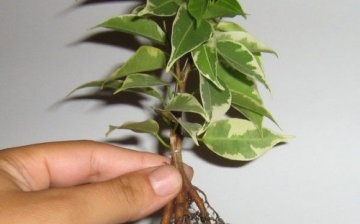





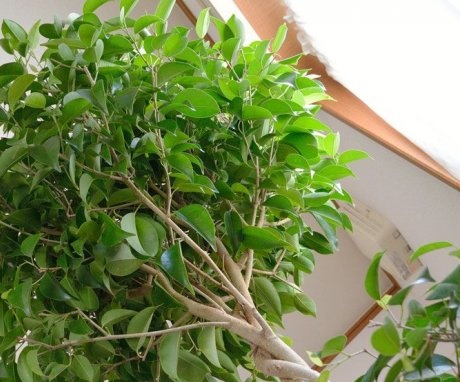
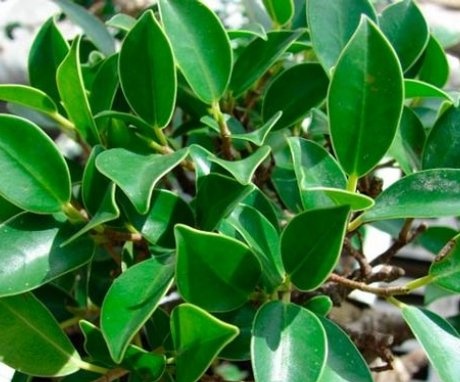
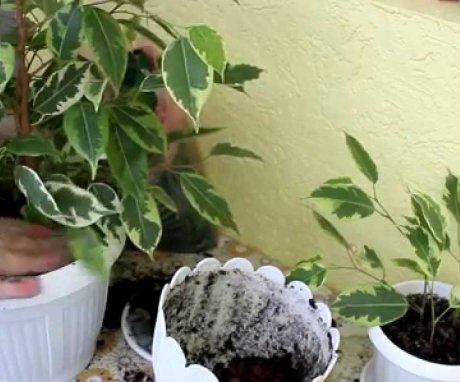
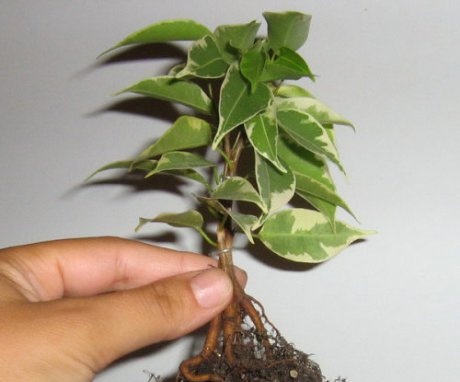
I have such a ficus growing and the only thing that worries me is that it periodically sheds its leaves. I water it sparingly, as the soil dries up. But a draft or bright light may be the reason. I will look for a new place for the flower.
We have several types of ficus growing at home, they differ in size and color of foliage. Some of them grow quite well, and some quickly shed their foliage and look sickly. I have never sprayed ficuses, maybe this is the case?
I have a bush ficus growing. Quite unpretentious plant. I have no special care for him. I water it on time, occasionally feed it with a universal complex fertilizer for indoor plants and everything is in order.